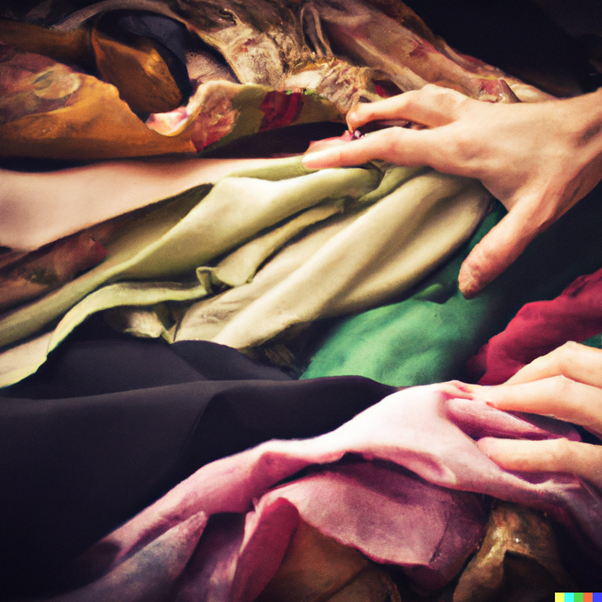- Organic cotton is considered the most sustainable material in fashion because it is grown without the use of harmful pesticides and fertilizers, which can pollute soil and water and have negative health effects on farmers and workers. Organic cotton is also biodegradable and can be composted at the end of its life.
- Linen is another sustainable material that is made from the flax plant, which requires minimal water and chemicals to grow. Linen is also biodegradable and has a naturally low environmental impact.
- Wool is a sustainable material because it is a natural and renewable resource, and it can be produced without the use of harmful chemicals. Wool is also biodegradable and can be composted at the end of its life.
- Hemp is a sustainable material because it is a fast-growing plant that requires little water and can be grown without the use of pesticides and fertilizers. Hemp is also biodegradable and can be recycled or composted at the end of its life.
- Recycled materials, such as recycled polyester, are sustainable because they are made from waste materials that would otherwise end up in landfills. Recycling these materials reduces pollution and waste and reduces the demand for new materials.
- Natural dyes, such as plant-based dyes, are sustainable because they are made from natural materials and do not require the use of harmful chemicals. Natural dyes are also biodegradable and do not pollute the environment.
- Pineapple leather, also known as Piñatex, is a sustainable material made from the fibers of pineapple leaves. This material is sustainable because it uses a waste product from the pineapple industry and requires minimal water and energy to produce. Pineapple leather is also biodegradable and can be composted at the end of its life.
- Mushroom leather is another innovative and sustainable material that is made from mushroom mycelium, the root-like structure of mushrooms. This material is sustainable because it uses a waste product from the mushroom industry and can be grown without the use of pesticides or fertilizers. Mushroom leather is also biodegradable and can be composted at the end of its life.
- Orange peel leather is a sustainable material made from the waste peel of oranges. This material is sustainable because it uses a waste product from the citrus industry and requires minimal water and energy to produce. Orange peel leather is also biodegradable and can be composted at the end of its life.
- Cork leather is a sustainable material made from the bark of the cork oak tree. This material is sustainable because it is harvested from the tree without harming the tree, and the bark regrows within a few years. Cork leather is also biodegradable and can be composted at the end of its life.
- Bamboo fabric is a sustainable material made from the fast-growing bamboo plant. This material is sustainable because it requires minimal water and pesticides to grow, and it can be grown in a variety of climates. Bamboo fabric is also biodegradable and can be composted at the end of its life.
- Milk fiber is a sustainable material made from milk protein. This material is sustainable because it uses a waste product from the dairy industry and requires minimal water and energy to produce. Milk fiber is also biodegradable and can be composted at the end of its life.
- Eucalyptus fabric is a sustainable material made from the fast-growing eucalyptus tree. This material is sustainable because it requires minimal water and pesticides to grow, and it can be grown in a variety of climates. Eucalyptus fabric is also biodegradable and can be composted at the end of its life.
- Algae fabric is a sustainable material made from algae biomass. This material is sustainable because it uses a waste product from the algae industry and can be grown without the use of pesticides or fertilizers. Algae fabric is also biodegradable and can be composted at the end of its life.
- Coconut fabric is a sustainable material made from the fiber of coconut husks. This material is sustainable because it uses a waste product from the coconut industry and requires minimal water and energy to produce. Coconut fabric is also biodegradable and can be composted at the end of its life.
- Corn fabric is a sustainable material made from corn starch. This material is sustainable because it uses a waste product from the corn industry and requires minimal water and energy to produce. Corn fabric is also biodegradable and can be composted at the end of its life.
In the future, it is likely that more innovative and sustainable fabrics will be developed. For example, researchers are working on developing fabrics made from renewable resources such as seaweed, corn husks, and plant-based plastics. These materials are sustainable because they use waste products or renewable resources and require minimal water and energy to produce.
In addition to new materials, there is also a growing focus on sustainable fashion production processes. For example, some companies are using circular fashion systems, where clothing is designed to be easily repaired, recycled, or composted at the end of its life. This reduces waste and pollution and extends the life of clothing.
Additionally, there is a rising desire for openness in the fashion business as customers want to know more about the origins and manufacturing processes of the items they buy. Given the rising expectations placed on businesses to uphold high standards of environmental and social responsibility, this is encouraging more accountability and sustainability in the fashion industry.
Overall, new eco-friendly materials and production techniques are being created, which bodes well for the future of sustainable fashion. Consumers may significantly influence this transition by supporting ethical fashion methods and buying environmentally friendly clothing.

